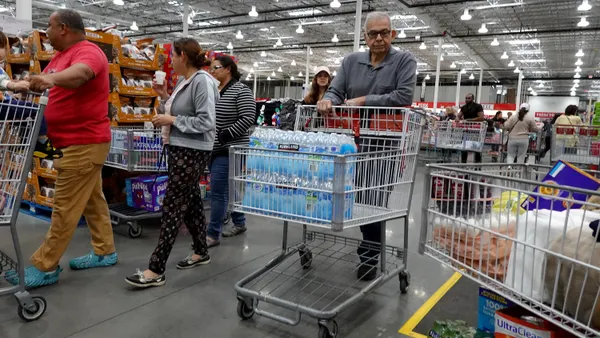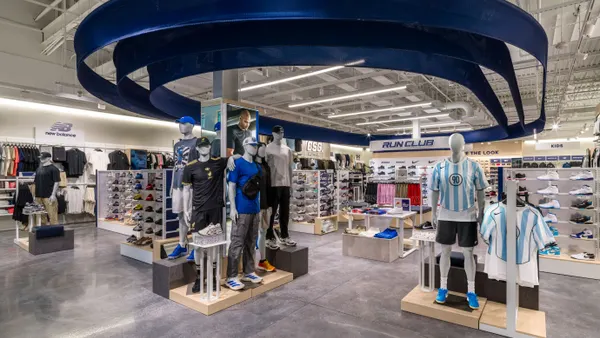Last week was one most U.S. grocers would like to forget.
First came news that Aldi would invest $3.4 billion to increase its store count by nearly a thousand locations. Three days later, fellow discounter Lidl opened its doors, ushering in a low-price, quality-driven model that took Europe by storm and aims to do the same in America.
Then the bombshell arrived: Amazon had offered to buy Whole Foods for $13.7 billion.
For grocers weary from waging price wars, battling deflation and struggling to stay relevant amidst increasing competition for food dollars, the moves by Aldi and Lidl were two more blows in an already long and difficult battle. Amazon’s acquisition of the natural and organic foods pioneer, on the other hand, seemed to signal a tidal change in grocery retail that left many wondering what the larger impact would be on the industry.
In interviews with Food Dive, analysts said they expect the purchase of Whole Foods to accelerate existing trends in the industry while also changing the consumer's expectations around the integration of digital and traditional shopping methods. The result will likely be a need for further investments from grocers already strapped for investment capital.
Here are six areas where Amazon’s acquisition could impact the grocery industry in the months and years to come:
1.) Pricing pressure
It’s a familiar story throughout retail: Amazon enters a category with the lowest prices around, pressures other retailers to drop their prices, then steadily chips away at their market share.
Amazon’s reach with Whole foods will be more limited, but grocers that operate natural and organic stores could see a similar effect. If Amazon attacks Whole Foods’ “Whole Paycheck” image, as many expect the company will, significant price reductions will roll out across stores.
Other grocers will feel pressured to lower prices on their high-margin specialty goods as a result. It's a logical reaction, but according to sources, it could be a very dangerous one considering many supermarkets are already reducing prices on their staples and lower-cost goods to compete with discounters and Walmart.
“It becomes a really slippery slope to compete on price on two fronts,” Diana Sheehan, director of retail insights with Kantar Retail, told Food Dive.
2.) Further industry consolidation
Mergers and acquisitions have heated up in recent years as grocers seek scale and efficiencies in an increasingly crowded industry. Amazon’s acquisition of Whole Foods will likely drive further consolidation, sources say, but the primary goal may be to diversify rather than save money.
Sheehan believes strong small and regional chains will be targets for acquisition, considering their strengths in local markets and relatively low price tags. Meanwhile, Neil Stern, senior partner with consulting firm McMillanDoolittle, said a large retailer such as Kroger or Target could buy up a natural and organic chain like Sprouts Farmers Market. This would serve as a weapon against an ascendant Whole Foods, not to mention shore up its presence in a high-growth category.
“Certainly for Sprouts, the likelihood of an acquisition has gone up,” Stern told Food Dive. “They could become a strategic piece of someone else’s portfolio.”
3.) Raising the stakes on e-commerce
As an online-only grocer, Amazon has struggled to grow its footprint beyond a collection of urban markets. After ten years in operation, its Fresh service is available in just 16 cities.
With Whole Foods’ stores in its arsenal, Amazon would add a crucial brick-and-mortar dimension to its grocery e-commerce ambitions. Many expect Amazon to add click-and-collect operations to stores, especially in Whole Foods’ traffic-starved suburban locations. Home delivery also will be on the table. Sources expect Amazon will carve out efficiencies — like using its Fresh service to fulfill orders rather than having workers pick store products — to become best-in-class in many markets.
Amazon’s efforts in this space will pressure other grocers to funnel more money into marketing and developing their online shopping platforms. This could pay off in the long run, but for now these platforms are, for many retailers, inefficient and very difficult to convert into profit.
“One- and two-hour delivery are table stakes for grocery e-commerce, and Amazon’s move accelerates that movement,” Michelle Grant, head of retailing at Euromonitor International, told Food Dive.
4.) Private label evolution
Many analysts expect Amazon to grow Whole Foods’ 365 brand by funding its in-store development as well as selling it to millions of additional customers through Amazon.com. But the online giant has its own ambitions in private label, with brands like Mama Bear baby food and Happy Belly snacks and coffee gaining traction on its site.
Jack O’Leary, an analyst with consulting firm Planet Retail RNG, said he expects Amazon to offer some of these brands in Whole Foods stores. Additionally, the e-tailer will likely use Whole Foods’ expertise and store shelves to develop more private label lines.
“It’ll be interesting to see how the two retailers blend their assortments and build off each other in private label,” O’Leary told Food Dive.
Amazons deep pockets, experimental spirit and fresh outlook on physical retail could make for some innovative brands that challenge retailers and inspire further development in an already fast-growing segment of the industry.
5.) Greater expectations for in-store tech
When Amazon announced its intention to acquire Whole Foods last week, minds immediately leapt to the technological wonders the world’s largest online retailer could bring to hundreds of grocery stores. Perhaps every Whole Foods will feature checkout-free Amazon Go technology, drone delivery of online orders or sensors to track customers and interact with them as they walk the store.
“At a time when grocers are facing margin compression from the expansion of discounters like Lidl, the prospect of having to spend more on in-store technology and digital platforms to keep up with the Amazon behemoth is highly unattractive.”

Neil Saunders
Managing director of GlobalData Retail
Sources told Food Dive that practical technology, like improved back-end systems, will do more to enhance Whole Foods’ profitability in the short term. But there’s no doubt tech-savy, data-driven Amazon will push the envelope on customer-facing technology. The e-tailer could offer recommendations to Prime members that integrate their online and in-store preferences. Amazon also could leverage its storehouse of Prime accounts, including payment information, to speed up checkout and offer in-store specials.
Whatever Amazon chooses to do, it will likely increase consumer expectations and pressure retailers to step up their in-store tech game.
“At a time when grocers are facing margin compression from the expansion of discounters like Lidl, the prospect of having to spend more on in-store technology and digital platforms to keep up with the Amazon behemoth is highly unattractive,” Neil Saunders, managing director of GlobalData Retail, wrote in a note emailed to Food Dive.
6.) The X-factor
It’s difficult to predict with any certainty what exactly Amazon will do with Whole Foods. The template for what happens when a large online retailer buys a large natural and organic chain simply doesn’t exist. Reports have noted that because the deal came together so quickly even Amazon doesn’t fully know how it will leverage the acquisition.
So while observers can say Amazon will make strides in e-commerce and in-store technology, it’s difficult to know precisely what the e-tailer will do in these areas and what other elements of the physical retail environment it might alter.
“In Amazon, you have this competitor who can reimagine the store in ways the old physical-first stores cannot,” said Grant.
One things is for certain: If its acquisition of Whole Foods goes through, which many expect it will, Amazon's every move will be closely watched by the grocery industry.















